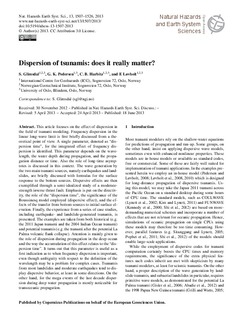| dc.description.abstract | This article focuses on the effect of dispersion in the field of tsunami modeling. Frequency dispersion in the linear long-wave limit is first briefly discussed from a theoretical point of view. A single parameter, denoted as "dispersion time", for the integrated effect of frequency dispersion is identified. This parameter depends on the wavelength, the water depth during propagation, and the propagation distance or time. Also the role of long-time asymptotes is discussed in this context. The wave generation by the two main tsunami sources, namely earthquakes and landslides, are briefly discussed with formulas for the surface response to the bottom sources. Dispersive effects are then exemplified through a semi-idealized study of a moderate-strength inverse thrust fault. Emphasis is put on the directivity, the role of the "dispersion time", the significance of the Boussinesq model employed (dispersive effect), and the effects of the transfer from bottom sources to initial surface elevation. Finally, the experience from a series of case studies, including earthquake- and landslide-generated tsunamis, is presented. The examples are taken from both historical (e.g. the 2011 Japan tsunami and the 2004 Indian Ocean tsunami) and potential tsunamis (e.g. the tsunami after the potential La Palma volcanic flank collapse). Attention is mainly given to the role of dispersion during propagation in the deep ocean and the way the accumulation of this effect relates to the "dispersion time". It turns out that this parameter is useful as a first indication as to when frequency dispersion is important, even though ambiguity with respect to the definition of the wavelength may be a problem for complex cases. Tsunamis from most landslides and moderate earthquakes tend to display dispersive behavior, at least in some directions. On the other hand, for the mega events of the last decade dispersion during deep water propagation is mostly noticeable for transoceanic propagation. | |
